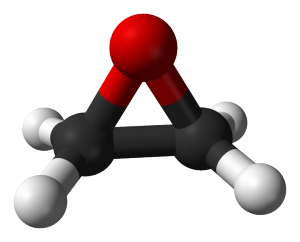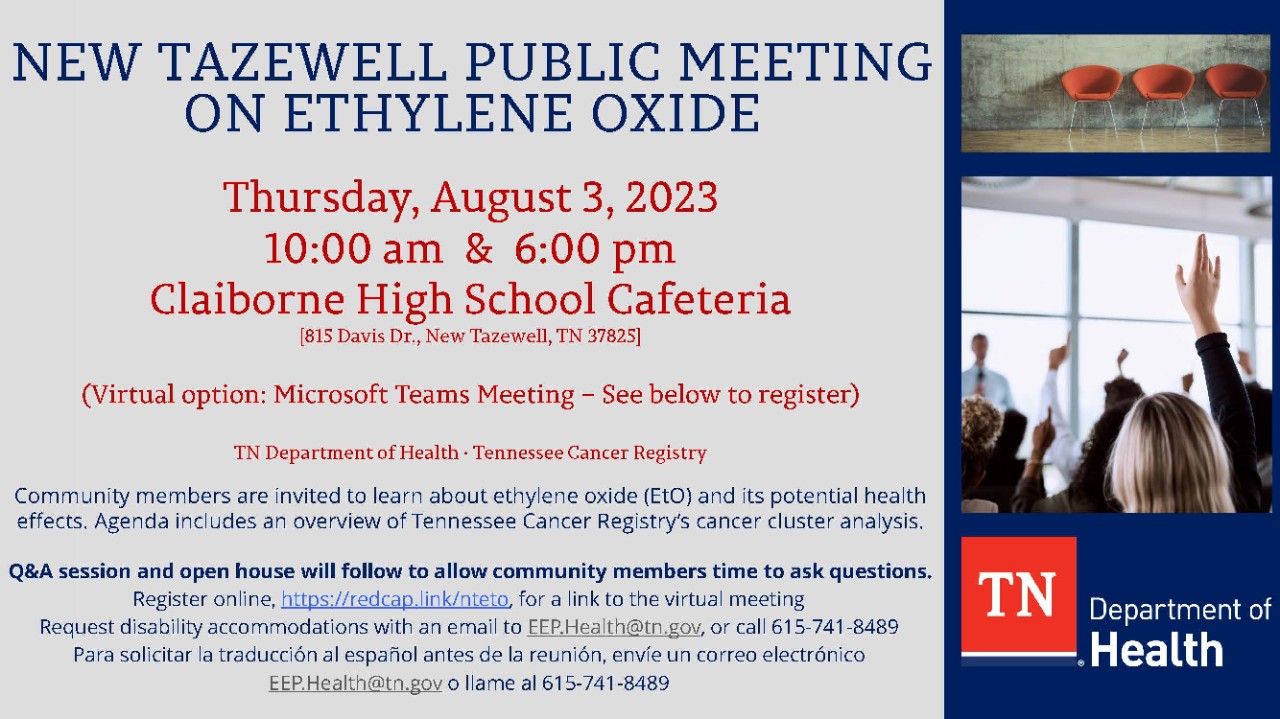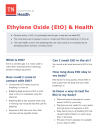Ethylene Oxide (EtO)
What is ethylene oxide?
Ethylene oxide (EtO) is a manmade, colorless gas.
EtO is most often used in two ways:
1) to make other chemicals needed for many everyday products like fabrics, plastics, antifreeze, detergents, glues, and make-up, and
2) to disinfect equipment that cannot be cleaned by steam, mostly for the medical industry.
EtO is also used to sterilize some food products, such as spices, dried herbs and vegetables, sesame seeds, and walnuts.
How is EtO regulated?
EtO emissions are controlled by the U.S. Environmental Protection Agency (EPA) under the Clean Air Act.
On March 14, 2024, EPA announced final amendments to the National Emission Standards for Hazardous Air Pollutants (NESHAP) for Ethylene Oxide Commercial Sterilizers.
How might I be exposed to EtO?
People who live near facilities releasing EtO may be exposed to EtO. Because EtO emissions are regulated by EPA, these facilities have equipment to capture most of the EtO emitted. The amount escaping the facility’s controls are called fugitive emissions. The amount of fugitive emissions and how close someone lives to the facility will affect their exposure. EPA's amendment to the NESHAP for ethylene oxide commercial sterilizers, finalized in March 2024, will reduce EtO emissions by over 90 percent, reducing cancer risk in dozens of communities nationwide. Commercial sterilizations companies will have two to three years, depending on the amount of EtO used, to comply with the new regulation. Once the rule is in full effect, no individual will be exposed to EtO at levels that correspond to a lifetime cancer risk of greater than 100-in-1 million. For more information please refer to the Government Partners section of this website.
Workers may be exposed to EtO if they work in places where EtO is produced or used, such as chemical plants and commercial and hospital sterilizers. These workers may have higher-than-average exposure.
What are possible health effects of EtO?
EPA does not expect EtO levels in the outdoor air around facilities to be high enough to cause instant, or “acute,” effects.
Short-term inhalation exposure to high amounts of EtO can cause dizziness, nausea, headaches, tiredness, respiratory irritation, and in some cases vomiting and other types of stomach distress.
EtO can cause cancer. Studies of workers exposed to high levels of EtO over an average of 10 years or longer had higher risks of certain types of cancer, such as some blood cancers and breast cancer. Similar cancers were also found in animal studies.
For non-occupational settings, the greatest cancer risk is for people who have lived near an EtO-releasing facility for their entire lifetime.
Is there a test to check if I've been exposed to EtO?
According to the Agency for Toxic Substances and Disease Registry (ATSDR) two kinds of tests can show if you have been recently exposed to EtO. One test measures EtO in blood and the other measures it in breath. However, these tests are not meant for individuals exposed at low levels of EtO. Additionally, once exposure stops, EtO leaves the body within hours or days, so a medical test may not show if you have been exposed in the past. These tests cannot be used to predict how EtO will affect a person’s health and are not usually available in a doctor’s office.
Government partners
Agency for Toxic Substances and Disease Registry (ATSDR)
Ethylene Oxide
wwwn.cdc.gov/TSP/substances/ToxSubstance.aspx?toxid=133
Toxicological Profile for Ethylene Oxide
wwwn.cdc.gov/TSP/ToxProfiles/ToxProfiles.aspx?id=734&tid=133
Centers for Disease Control and Prevention (CDC)
Ethylene Oxide "Gas" Sterilization
www.cdc.gov/infectioncontrol/guidelines/disinfection/sterilization/ethylene-oxide.html
Environmental Protection Agency (EPA)
Ethylene Oxide (EtO)
www.epa.gov/ingredients-used-pesticide-products/ethylene-oxide-eto
Hazardous Air Pollutants: Ethylene Oxide (EtO)
www.epa.gov/hazardous-air-pollutants-ethylene-oxide
Frequent Questions: Health Information About Ethylene Oxide
www.epa.gov/hazardous-air-pollutants-ethylene-oxide/frequent-questions-health-information-about-ethylene-oxide
Final Amendments to Strengthen Air Toxics Standards for Ethylene Oxide Commercial Sterilizers
https://www.epa.gov/hazardous-air-pollutants-ethylene-oxide/final-amendments-strengthen-air-toxics-standards-ethylene
National Institute for Occupational Safety and Health (NIOSH)
Ethylene Oxide
www.cdc.gov/niosh/topics/ethyleneoxide/default.html
Occupational Safety and Health Administration (OSHA)
Ethylene Oxide
www.osha.gov/ethylene-oxide
National Institutes of Health: National Cancer Institute
Ethylene Oxide
www.cancer.gov/about-cancer/causes-prevention/risk/substances/ethylene-oxide
Food and Drug Administration (FDA)
Sterilization for Medical Devices
www.fda.gov/medical-devices/general-hospital-devices-and-supplies/sterilization-medical-devices
Tennessee Department of Environment and Conservation (TDEC)
EtO
https://www.tn.gov/environment/air/ethylene-oxide.html
Additional resources
Texas Commission on Environmental Quality
Ethylene Oxide (EtO) Carcinogenic Dose-Response Assessment
https://www.tceq.texas.gov/toxicology/ethylene-oxide
Helpful documents
Agency for Toxic Substances and Disease Registry (ATSDR)
ToxFAQs for Ethylene Oxide
www.atsdr.cdc.gov/toxfaqs/tfacts137.pdf
Etyhlene Oxide
https://wwwn.cdc.gov/TSP/substances/ToxSubstance.aspx?toxid=133
ToxGuide for Ethylene Oxide C2H4O
www.atsdr.cdc.gov/toxguides/toxguide-137.pdf
Toxicological Profile for Ethylene Oxide
www.atsdr.cdc.gov/toxprofiles/tp137.pdf
Clinician Brief: Ethylene Oxide
https://www.atsdr.cdc.gov/emes/health_professionals/clinician-brief-ethylene-oxide_info.html
Occupational Safety and Health Administration (OSHA)
OSHA Fact Sheet: Ethylene Oxide
www.osha.gov/sites/default/files/publications/ethylene-oxide-factsheet.pdf
Upcoming Events or Activities
New Tazewell Public Meeting on Ethylene Oxide: August 3, 2023





